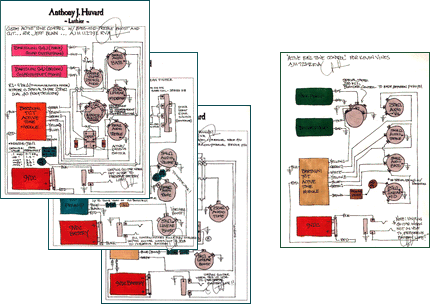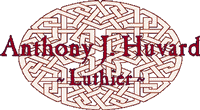Active tone controls are obviously not for everyone. They create a pretty hot signal and some guitarists simply do not like the sound they get from active electronics; they prefer standard passive tone controls. What is the difference you ask? Well, not to over simplify the answer consider this. . . In a passive circuit the raw signal generated by the pickups is then filtered through capacitors and variable resistors removing unwanted frequencies. Thus, when you roll the tone control counterclockwise you are removing a large chunk of the high frequencies that add to your overall sound (upper partials, harmonics, etc.). Sometimes a bleed capacitor used on the volume pot will help pass high frequencies at lower volumes, but the bottom line is a passive circuit works by filtering out unwanted frequencies.

I have developed a system of "cartoon" schematics that illustrate how each system is wired. . . so that a working musician on the road can easily repair a loose wire or defective component. They need not understand dc electronics or how to interpret a traditional schematic. Each device is pictured in cartoon form and each wire in the circuit is very easy to locate and trace. Roadies love this!
An active circuit on the other hand, uses an electronic amplifier and filter system to boost or retard selected frequencies and generally increase the output of the pickups, resulting in a much higher signal to noise ratio and transmission of harmonics and partials that might normally be lost to the impedance of your guitar cable. Your amplifier receives a much hotter signal and you have much more control over tone. Preamps built today are sometimes built right into the pickup itself and if any additional circuitry or switching, etc. is required special components must be used to facilitate the desired changes, and basically the sound they create is the sound you get. The preamps that I use are manufactured by Bill Bartolini. He has been making active pickups, tone circuits, and polyphonic pickups since 1974 (few realize that Bill is a flamenco guitar builder as well). His preamps allow the builder to design and configure a myriad of tone circuits while still retaining the "character" of passive pickups. Bartolini pickups are superbly made; they're internally shielded to reduce noise and unwanted hum and are visibly superior in quality of design and materials to almost every other pickup on the market. I use Bartolini pickups on my finest instruments and I have used his active tone circuits to satisfy the "critical ear" of many of working professional musicians. Here is their address:
Bartolini Pickups and Electronics
2133 Research Drive, # 16
Livermore, California 94550
(510) 443-1037
A properly designed active system will enhance the sound developed by any guitar allowing the player micro control over tonality and the ability to boost the gain of the circuit from a knob on the guitar. Basically this means you can create whatever sound you want. Bass players especially love active systems. Bartolini manufactures several different preamps. Some allow boost/cut control over treble and bass independently, some allow independent control over treble, midrange and bass frequencies and all allow the builder to insert special filters to enhance or retard selected frequencies. The player can have "just the sound" they've been looking for.

Pictured above is the "cartoon" schematic of an active tone circuit found on a hot rod Telecaster® style hybrid I built in 1990. Look closely and you will see a selectable dual coil pickup in the neck position allowing you to choose parallel wired hum-cancelling mode, a single bass coil, or a series wired hum-canceler. A shielded, stacked, hum-cancelling single coil in the middle position, and in the bridge position, custom switching allows parallel wired hum-canceler, a single treble coil, or series wired humbucking mode. The pickup bank is funneled through a standard Strat® style 5 position switch selecting neck only, neck and middle, middle only, middle and bridge, and bridge only combinations. In positions two and four, a separate phase switch allows the middle pickup, when being played in combination with either of the other two pickups, to be either "in" or "out" of phase. The signal is then vectored through a preamp and master volume and tone controls. In this instance, the tone control acts as a standard control in zero through nine positions, and then when cranked full open to ten, the preamp boost mode is engaged. A single 9 VDC battery powers the circuit. The battery is switched via a stereo output jack.



